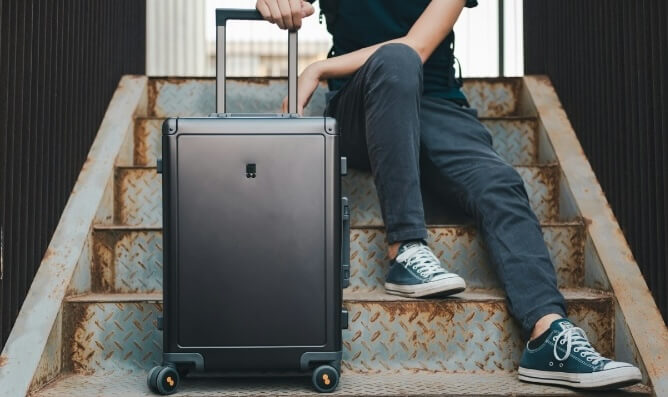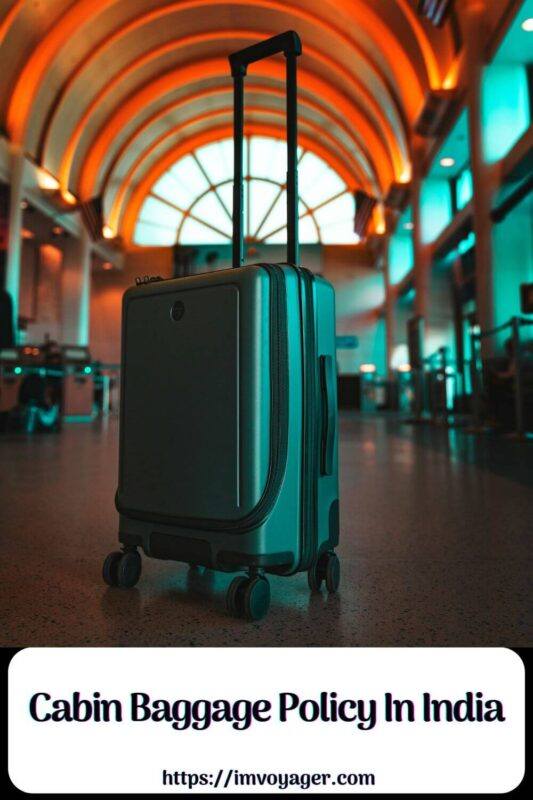Air travel in India has grown exponentially in the past decade, with more and more passengers taking to the skies every day. The Indian aviation sector has made tremendous strides, with newer airlines, better service standards, and more advanced airports catering to the needs of a growing travel base. However, this boom has also brought along its own set of challenges.
Among these, managing the flow of passengers and ensuring smooth security checks at airports has become one of the top priorities. Amidst the hustle and bustle of modern-day air travel, one of the aspects that continue to evolve is the cabin baggage policy. With tighter security measures and the need to streamline operations, airlines in India have made significant changes in how we pack and travel.
Whether you are flying for business or leisure, it is crucial to be aware of the current regulations to avoid delays and fines. This post is all about helping you understand the cabin baggage policy in India, so you can travel smarter, safer, and without any last-minute surprises. Now, let us dive into the details of the rules governing your hand luggage.
Table of Contents
Important News for Travelers
With the increasing number of air travellers in India, new regulations by the Bureau of Civil Aviation Security (BCAS) and the Central Industrial Security Force (CISF) aim to streamline the cabin baggage process and ensure smoother airport experiences for all.
These updated rules have been implemented in response to the growing demand for efficient security checks, ensuring that the rising number of flyers is managed effectively while prioritizing safety. These changes are all set to make your journey through Indian airports a bit more predictable, reducing delays during security screening.
On this note, let us have a look at some of the key aspects of the newly introduced hand baggage rules, designed to make air travel more seamless and efficient for everyone.
Cabin Baggage Policy in India: One Piece of Hand Baggage Allowed Per Passenger
Travelling by air often means dealing with a lot of rules, especially when it comes to what you can bring onboard. One of the most basic yet important rules in India’s cabin baggage policy is the allowance of only one piece of hand baggage per passenger. This rule is designed to maintain order and prevent clutter in the overhead compartments and under-seat storage.
While it might seem restrictive, it actually helps streamline the boarding process and ensures that everyone has a safe and smooth flight. Whether you are packing for a short business trip or a long vacation, this rule encourages travellers to pack light and prioritize what is most important. So, whether you are flying with a well-known airline like IndiGo, Air India, or a budget carrier, you will need to stick to one carry-on.
The policy also reduces the chances of delays during boarding and helps in maximizing space for everyone. This rule applies regardless of the class of travel or the airline you choose, so it is essential to plan accordingly. For families travelling together, this rule is a bit more flexible, allowing parents to carry necessary items for infants, but other than that, each person gets only one piece.
Keeping this in mind while packing will save you time at the airport and ensure you do not face any unexpected challenges. It is always better to stick to this limit to avoid confusion and last-minute baggage check-ins.
Cabin Baggage Policy in India: Weight Limits for Different Classes
When you book a flight, the weight limit for your cabin baggage can depend on the class you are travelling in. For example, travellers in Business or First Class often enjoy a higher baggage allowance than those flying Economy Class. In India, the general guideline for cabin baggage weight in Economy Class is typically 7 kg, but this can vary slightly depending on the airline. However, if you are travelling in Business or First Class, you may be allowed up to 10 kg or more, offering you a bit more flexibility in what you can carry.
These weight limits are put in place to ensure that the aircraft stays balanced, especially as airlines cater to a wide range of passengers. Exceeding the limit could mean either repacking your bag or paying additional fees at the counter, so it is always a good idea to check the specifics for your airline. To make sure your bag is within weight limits, it is worth investing in a portable luggage scale before you leave home. This small effort can save you from unexpected hassles at the airport.
Keep in mind that different carriers might have different policies, so always check your airline’s terms and conditions when booking your flight. Additionally, even if you are carrying a small bag, remember that if it is too heavy, you might be asked to check it in. So, packing light and smart will not only help you avoid fees but also make your airport experience more comfortable.
Cabin Baggage Policy in India: Size Restrictions
Apart from weight, the size of your cabin baggage also matters. Airlines in India enforce strict size restrictions to ensure that your carry-on fits comfortably into the overhead bins or under the seat in front of you. The standard dimension allowed for a cabin bag is usually around 55 cm x 35 cm x 25 cm, but this can vary by a few centimetres depending on the airline. It is always best to check the specifics of your airline’s baggage policy to avoid any surprises.
If your bag exceeds these dimensions, you might be required to check it in, even if it does not exceed the weight limit. To help with packing, consider investing in soft-sided bags that can expand or compress based on how full they are. These bags are usually more flexible when it comes to fitting into the bins. Additionally, some airlines may allow you to carry an extra small personal item, like a laptop bag or purse, alongside your main piece of hand baggage.
However, this is typically at the discretion of the airline, and exceeding size limits could mean delays or additional charges. So, when packing your cabin baggage, ensure that it complies with the prescribed size restrictions to avoid the hassle of repacking or checking in your bag.
Cabin Baggage Policy in India: Enhanced Security
With the increasing number of air travellers in India, security has become a critical factor, and that is reflected in the newer, more stringent cabin baggage policies. The implementation of enhanced security measures is one of the primary reasons behind the stricter rules around carry-on baggage. As part of these measures, passengers are now required to comply with tighter restrictions on what can be brought inside the cabin.
Sharp objects like knives, scissors, and other potentially dangerous items are strictly prohibited, and liquid restrictions are also much more rigid. The 100 ml rule for liquids in transparent containers still holds true, and all such items need to be placed in a clear, resealable plastic bag for easier inspection. The aim is to create a safe and secure environment for all passengers.
Additionally, security staff at the airport may request passengers to undergo additional screening if they have items that appear suspicious or if their bags do not meet the set guidelines. So, while the process can feel tedious, these enhanced security steps are for your safety. Being aware of these rules and preparing your cabin baggage accordingly can make the entire process faster and less stressful. If you are unsure about whether an item is allowed, it is always best to leave it behind or pack it in your checked luggage.
Cabin Baggage Policy in India: Plan Your Hand Baggage Accordingly
When preparing for your flight, planning your hand baggage is more important than you might think. With so many guidelines surrounding size, weight, and content, it is essential to be strategic about what you pack in your carry-on. Start by considering the essentials: travel documents, medication, valuables, and a change of clothes are some of the must-haves. Then, think about the airline-specific regulations that you will need to follow.
If you are travelling on a low-cost carrier, be especially mindful of weight restrictions and pack light. For longer flights, consider adding comfort items like neck pillows, snacks, and entertainment, but make sure they fit within the limits. One handy tip is to roll your clothes instead of folding them—this not only saves space but helps you avoid wrinkles.
If you are flying internationally or across long distances, packing a small power bank for your electronics is a wise choice. Just remember to avoid items that could trigger security alarms or violate airline policies, such as sharp objects or large containers of liquids. Overall, being organized and strategic will help you avoid rushing through airport security or having to pay unexpected baggage fees. It is also helpful to check your airline’s cabin baggage guidelines before you pack, as they can sometimes change based on the route or aircraft type.
Cabin Baggage Policy In India – FAQs
Understanding the cabin baggage policy is crucial for a smooth travel experience in India. Below are answers to some frequently asked questions to help you navigate the rules and regulations effortlessly.
What is the maximum weight allowed for cabin baggage on domestic flights in India?
Typically, the maximum weight for cabin baggage is 7 kg for Economy Class, and up to 10 kg for Business and First Class. However, this can vary by airline, so it is always good to check with the carrier directly.
Can I carry a laptop and a handbag together as part of my cabin baggage?
Yes, many airlines in India allow passengers to carry both a laptop bag and a personal handbag in addition to the main piece of hand baggage. However, this depends on the airline’s policy.
What items are prohibited in cabin baggage?
Sharp objects, flammable items, and large quantities of liquids (over 100 ml) are typically prohibited. Always check the specific restrictions of the airline you are flying with.
Are there any allowances for passengers with infants or young children?
Yes, passengers travelling with infants are allowed to carry additional items like baby food, diapers, and a small stroller. These items are typically exempt from the one-piece limit for hand baggage.
Can I carry liquid items in my cabin baggage?
Yes, you can carry liquids, but they must be in containers of no more than 100 ml each, and all liquid items must be placed in a transparent, resealable plastic bag.
What happens if my cabin baggage exceeds the allowed size or weight?
If your cabin baggage exceeds the allowed size or weight, you may be asked to check it in or pay additional fees depending on the airline’s policy.
Can I carry power banks in my cabin baggage?
Yes, power banks are allowed in cabin baggage but must not exceed a certain capacity (usually around 20,000 mAh). Airlines have specific rules regarding power banks, so be sure to check.
How strict are airlines about cabin baggage rules in India?
Airlines in India are generally strict about their cabin baggage policies, and exceeding limits can result in additional charges or having to check in your bag.
Is it possible to carry extra bags if I am travelling with a companion?
No, each passenger is allowed only one piece of cabin baggage, regardless of whether you are travelling alone or with someone else.
What should I do if my cabin bag gets damaged at the airport?
If your cabin baggage gets damaged during security screening or while being handled by airport staff, you should report it to the airline’s customer service desk immediately.
Can I carry food items in my cabin baggage?
Yes, you can carry food items, but make sure they comply with the liquid and sharp object restrictions.
Are there any exceptions to the one-piece rule for cabin baggage?
Some airlines may make exceptions for medical devices, duty-free items, or assistive devices, but you should confirm this with your airline.
Understanding India’s cabin baggage policy is key to ensuring a smooth and stress-free journey. With various restrictions on weight, size, and security, it is always wise to plan ahead and pack accordingly. Being mindful of these guidelines will help you avoid unnecessary delays, additional charges, and the hassle of repacking your bag at the airport.
Whether you are flying for business or leisure, keeping your carry-on within the prescribed limits allows you to breeze through check-in and security with ease. So, next time you are booking a flight, take a few moments to familiarize yourself with the airline’s cabin baggage policies. A little preparation goes a long way in making your air travel experience more enjoyable and hassle-free!
We hope you found this post about cabin baggage policies in India – Carry-on Luggage in Flights in India helpful. Whether you are preparing for a short domestic flight or an international journey, knowing the cabin baggage rules is essential for smooth travel. This post aimed to break down the key aspects of carrying cabin baggage, including size and weight limits, as well as what items you can or cannot bring onboard.
What is your opinion on the cabin baggage policy in India? Feel free to share your thoughts in the comments below. And if you found this post useful, be sure to spread the word — share it with your friends and across your social networks!
Stay tuned for more exciting travel content, including detailed itineraries, expert tips, and the best off-the-beaten-path destinations. Ready to plan your next adventure? Subscribe to our blog and newsletter for exclusive insights and all the inspiration you need to explore the world like never before.
For an even deeper dive into India’s incredible culture, landscapes, and cuisine, check out our YouTube channel, Travel With Sandy & Vyjay. Join us as we share unforgettable journeys that will inspire your next getaway. From thrilling adventures to peaceful retreats, we bring you along for every moment.
Keep up with us on Facebook, Instagram, X (formerly Twitter), LinkedIn, and YouTube for daily updates, travel tips, and unique experiences. We offer insider info to make your travels even more memorable—whether it is a hidden gem or a must-see landmark.
Do not miss out on the latest content! Subscribe to our Voyager Travel Bytes newsletter for updates straight to your inbox or WhatsApp. And for a daily dose of wanderlust, follow us on Instagram—we’ll help turn your travel dreams into reality. Let’s make your next trip truly extraordinary!
We are a reader-supported site. This means, at no additional cost to you, we may earn a small commission if you book a flight or hotel, or make a purchase through one of our affiliate links. Thank you for your support!
Flights – Air India (Domestic) or Air India (International), or Priceline
Tours – Click to book top tours around the world. Book tours and activities here.
Experiences – Book your next unforgettable experience here, with flexible bookings and free cancellations. Reserve tours and activities now and pay later.
Hotels – Click to book the best hotels/resorts. Choose the best stay options with TripAdvisor or Hotels.com, or HotelsCombined
Travel Insurance – Click to book Travel Insurance that covers a range of travel insurance and safety services including medical emergencies, lost luggage, trip cancellation and more
Visas and Travel Documents Application – Click here for Online Travel Visa Check
Online Passport Photo – Get Your Passport Photo Online here

Do You Love Traveling?
Do you want to know how to travel the world? We have put together a very useful travel resources page with the best travel tips. Go check it out now. Thanks for visiting our site Voyager - imvoyager.com and taking the time to read this post! If you wish to collaborate/work with us then reach us at [email protected] We’d love it if you’d comment by sharing your thoughts on this post and share this post on social media and with your friends. Follow our journey on our social media channels: Facebook X Instagram Pinterest YouTube
Start dreaming about your next adventure with Tripadvisor. Book your next unforgettable experience here with flexible bookings and free cancellations.
Flight booking online at the best fare
60+ Million Users Trust TripAdvisor With Their Travel Plans. Shouldn't You?

Sandy & Vyjay are a husband and wife duo who are travel content creators. They are co-founders of this travel website and are one of the leading travel content creators in India.
Sandy & Vyjay quit their successful corporate careers to pursue their passion for travel and writing full-time. Their dedication has earned them the “Best Travel Writer” award and numerous accolades on both national and international stages. Focusing on India’s destinations, heritage, and culture, they are passionate advocates for nature and the environment. Through their content, they promote ecotourism and sustainable travel, inspiring others to explore and preserve the beauty of India.








